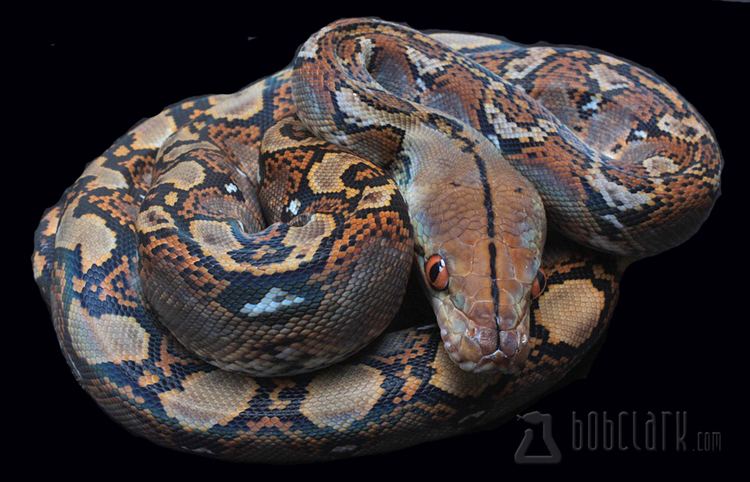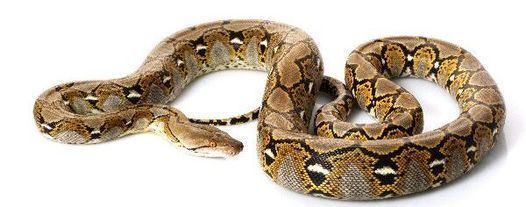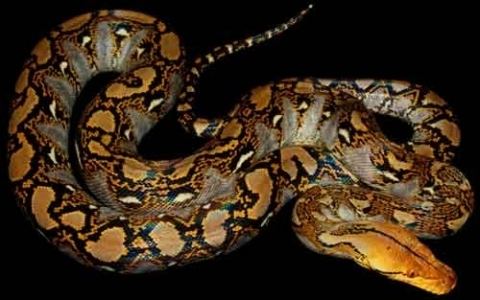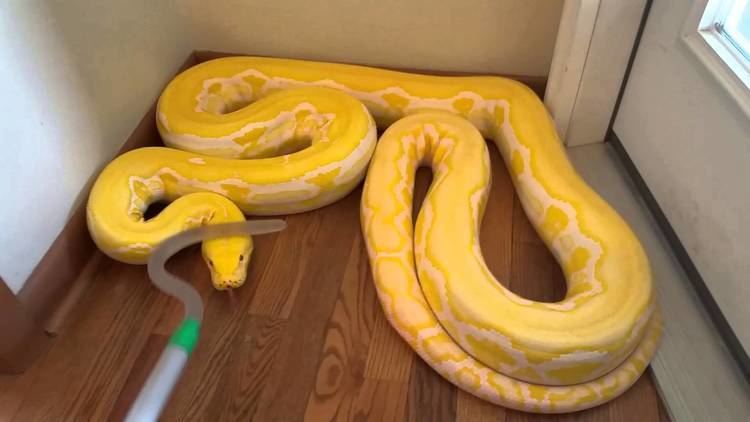Genus Python Mass 160 kg Higher classification Python | Phylum Chordata Suborder Serpentes Scientific name Python reticulatus Rank Species | |
 | ||
Similar Snake, Python, Python family, Burmese python, Reptile | ||
Huge reticulated python
The reticulated python (Python reticulatus) is a species of python found in Southeast Asia. They are the world's longest snakes and longest reptiles and among the three heaviest snakes. Like all pythons, they are nonvenomous constrictors and normally not considered dangerous to humans. Although large specimens are powerful enough to kill an adult human, attacks are only occasionally reported.
Contents
- Huge reticulated python
- Austin stevens reticulated python
- Description
- Geographic range
- Habitat
- Feeding
- Danger to humans
- Reproduction
- Captivity
- Taxonomy
- References

An excellent swimmer, P. reticulatus has been reported far out at sea and has colonized many small islands within its range. The specific name, reticulatus, is Latin meaning "net-like", or reticulated, and is a reference to the complex color pattern.

Austin stevens reticulated python
Description

This species is the largest snake native to Asia. More than a thousand wild reticulated pythons in southern Sumatra were studied and estimated to have a length range of 1.5 to 6.5 m (4.9 to 21.3 ft) and a weight range of 1 to 75 kg (2.2 to 165.3 lb). Reticulated pythons with lengths more than 6 m (19.7 ft) are rare, though according to the Guinness Book of World Records, it is the only extant snake to regularly exceed that length. A reticulated python of the same length as a green anaconda may weigh only half as much as the bulkier anaconda. One of the largest scientifically measured specimens, from Balikpapan, East Kalimantan, Indonesia, was measured under anesthesia at 6.95 m (22.8 ft) and weighed 59 kg (130 lb) after not having eaten for nearly 3 months. Widely published data of specimens that were reported to be several feet longer have not been confirmed.

The specimen once widely accepted as the largest-ever "accurately" measured snake, that being Colossus, a specimen kept at the Highland Park Zoo (now the Pittsburgh Zoo and PPG Aquarium) in Pittsburgh, Pennsylvania, during the 1950s and early 1960s, with a peak reported length of 8.7 metres (28 ft 7 in) from a measurement in November 1956, was later shown to have been substantially shorter than previously reported. When Colossus died on April 14, 1963, its body was deposited in the Carnegie Museum of Natural History. At that time, its skeleton was measured and found to be 20 ft 10 in (6.35 m) in total length, and the length of its fresh hide was measured as 23 ft 11 in (7.29 m) – both measurements being significantly shorter than what had been previously estimated in 1956. The hide tends to stretch from the skinning process, and thus be longer than the snake from which it came – e.g., by roughly 20–40% or more. The previous reports had been constructed by combining partial measurements with estimations to compensate for "kinks", since it is virtually impossible to completely straighten an extremely large live python. Because of these issues, a 2012 journal article concluded that "Colossus was neither the longest snake nor the heaviest snake ever maintained in captivity." Too large to be preserved with formaldehyde and then stored in alcohol, the specimen was instead prepared as a disarticulated skeleton. The hide was sent to a laboratory to be tanned, but it was either lost or destroyed, and now only the skull and selected vertebrae and ribs remain in the museum's collection. There is considerable confusion in the literature over whether Colossus was male or female (females tend to be larger).

Numerous reports have been made of larger snakes, but since none of these was measured by a scientist nor any of the specimens deposited at a museum, they must be regarded as unproven and possibly erroneous. In spite of what has been, for many years, a standing offer of a large financial reward (initially $1,000, later raised to $5,000, then $15,000 in 1978 and $50,000 in 1980) for a live, healthy snake over 30 ft (9.1 m) long by the New York Zoological Society (later renamed as the Wildlife Conservation Society), no attempt to claim this reward has ever been made.
The color pattern is a complex geometric pattern that incorporates different colors. The back typically has a series of irregular diamond shapes flanked by smaller markings with light centers. In this species' wide geographic range, much variation of size, color, and markings commonly occurs.
In zoo exhibits, the color pattern may seem garish, but in a shadowy jungle environment amid fallen leaves and debris, it allows them to virtually disappear. Called disruptive coloration, it protects them from predators and helps them to catch their prey.
The smooth dorsal scales are arranged in 69–79 rows at midbody. There are deep pits on four anterior upper labials, on two or three anterior lower labials, and on five or six posterior lower labials.
Geographic range
Reticulated pythons are found in South Asia from the Nicobar Islands, India, Pakistan, Bangladesh, Burma, Thailand, Laos, Cambodia, Vietnam, Malaysia, and Singapore, east through Indonesia and the Indo-Australian Archipelago (Sumatra, the Mentawai Islands, the Natuna Islands, Borneo, Sulawesi, Java, Lombok, Sumbawa, Sumba, Flores, Timor, Maluku, Tanimbar Islands) and the Philippines (Basilan, Bohol, Cebu, Leyte, Luzon, Mindanao, Mindoro, Negros, Palawan, Panay, Polillo, Samar, Tawi-Tawi). The original description does not include a type locality. Restricted to "Java" by Brongersma (1972).
Three subspecies have been proposed, but are not recognized in the Integrated Taxonomic Information System (ITIS). The color and size can vary a great deal among the subspecies described. Geographical location is a good key to establishing the subspecies, as each one has a distinct geographical range.
Habitat
The reticulated python lives in rain forests, woodlands, and nearby grasslands. It is also associated with rivers and is found in areas with nearby streams and lakes. An excellent swimmer, it has even been reported far out at sea and has consequently colonized many small islands within its range. During the early years of the 20th century, it is said to have been common even in busy parts of Bangkok, sometimes eating domestic animals.
Feeding
Their natural diet includes mammals and occasionally birds. Small specimens up to 3–4 m (9.8–13.1 ft) long eat mainly rodents such as rats, whereas larger individuals switch to prey such as Viverridae (e.g. civets and binturongs), and even primates and pigs. Near human habitation, they are known to snatch stray chickens, cats, and dogs on occasion. Among the largest, fully documented prey items to have been taken are a half-starved sun bear of 23 kilograms that was eaten by a 6.95-m (22.8-ft) specimen and took some ten weeks to digest, as well as pigs of more than 60 kg (132 lb). As a rule, these snakes seem able to swallow prey up to one-quarter their own length and up to their own weight. As with all pythons, they are primarily ambush hunters, usually waiting until prey wanders within strike range before seizing it in their coils and killing by constriction. However, at least one case is reported of a foraging python entering a forest hut and taking a child.
Danger to humans
Attacks on humans are rare, but this species has been responsible for several human fatalities, in both the wild and captivity. They are among the few snakes that have been suggested to prey on humans. Reports of human fatalities and unauthenticated sources of human consumption include:
Considering the known maximum prey size, it is technically possible for a full-grown specimen of P. reticulatus to open its jaws wide enough to swallow a human teenager, but the width of the shoulders of adult Homo sapiens would probably pose a problem for even a snake with sufficient size.
Reproduction
Oviparous, females lay between 15 and 80 eggs per clutch. At an optimum incubation temperature of 31–32 °C (88–90 °F), the eggs take an average of 88 days to hatch. Hatchlings are at least 2 ft (61 cm) in length.
Captivity
Increased popularity in the pet trade is due largely to increased efforts in captive breeding and selectively bred mutations such as the "albino" and "tiger" strains. They can make good captives, but keepers should have previous experience with such large constrictors to ensure safety to both animal and keeper. Although their interactivity and beauty draws much attention, some feel they are unpredictable. They do not attack humans by nature, but will bite and possibly constrict if they feel threatened, or mistake a hand for food. While not venomous, large pythons can inflict serious injuries, sometimes requiring stitches.
The huge size and attractive pattern of these snakes has made them favorite zoo exhibits, with several individuals claimed to be above 20 ft (6.1 m) in length and more than one claimed to be the largest in captivity. However, due to their huge size, immense strength, aggressive disposition, and the mobility of the skin relative to the body, it is very difficult to get exact length measurements on a living reticulated python, and weights are rarely indicative, as captive pythons are often obese. Claims made by zoos and animal parks are sometimes exaggerated, such as the claimed 14.85 m (48.7 ft) snake in Indonesia which was subsequently proven to be about 6.5 m (21.3 ft) long. For this reason, scientists do not accept the validity of length measurements unless performed on a dead or anesthetized snake which is later preserved in a museum collection or stored for scientific research.
Also, dwarf forms of reticulated pythons occur, from some islands that are northwest of Australia, and these are being selectively bred in captivity to be much smaller, resulting in animals often referred to as "super dwarfs". Adult male super dwarf reticulated pythons are typically about 5 feet (1.5 m) long, while females are typically a little longer.
Taxonomy
Three subspecies may be encountered, including two new ones:
The latter two are dwarf subspecies. Apparently, the population of the Sangihe Islands north of Sulawesi represents another such subspecies which is basal to the P. r. reticulatus plus P. r. jampeanus clade, but it is not yet formally described.
The proposed subspecies "dalegibbonsi", "euanedwardsi", "haydnmacphiei", "neilsonnemani", "patrickcouperi", and "stuartbigmorei" have not found general acceptance.
A phylogenetic study of pythons has suggested that the reticulated python as well as the Timor python are more closely related to Australasian pythons, suggesting that they are an intermediate form between the Australasian pythons and the Afro-Asian genus Python, and should therefore be placed in a separate genus. The genus name Broghammerus was proposed by Raymond T. Hoser in 2003/2004. However, this and a numerous other names by the same author were criticized by Kaiser et al. (2013), who proposed ignoring them for the purposes of nomenclature. Reynolds et al. subsequently described the genus Malayopython for this species and its sister species, the Timor python, calling the Timor python M. timoriensis. Hoser has since said that the Malayopython name is a junior synonym of Broghammerus and thus should not be recognized by the International Code of Zoological Nomenclature. Neither of these proposed reclassifications has been recognized by the ITIS, but Malayopython has been recognized by a number of subsequent authors and the Reptile Database.
